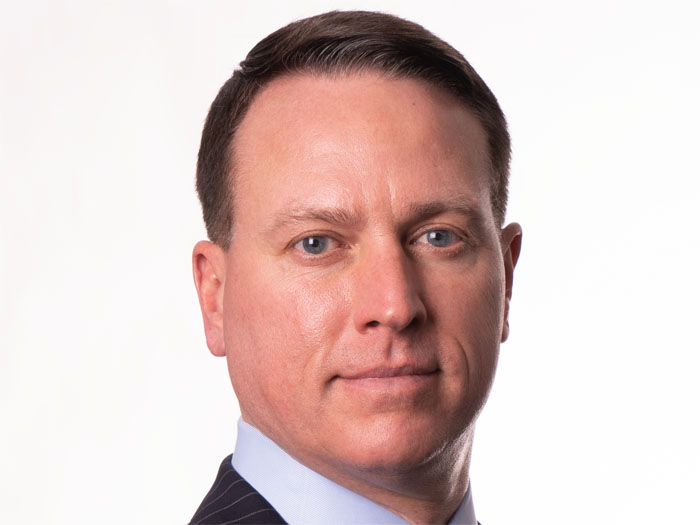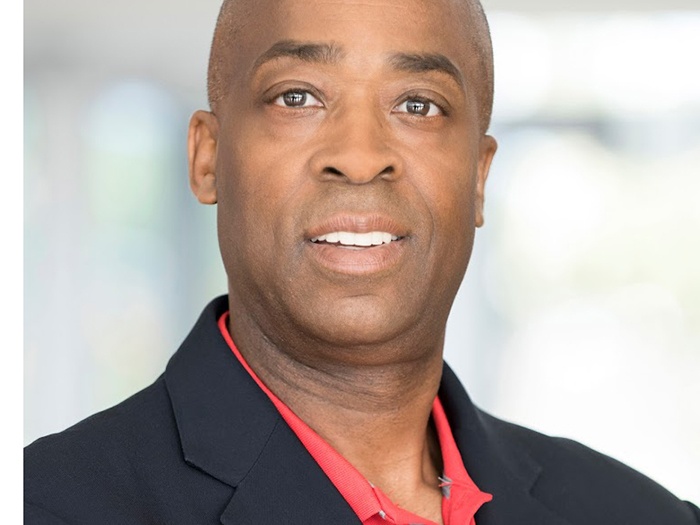Everest Insurance CEO Mike Karmilowicz Talks to Risk & Insurance About the Importance of Talent and the Rapid Expansion of Risk

Earlier this year, Risk & Insurance® editor-in-chief Dan Reynolds connected with Mike Karmilowicz, the president and CEO of Everest Insurance®.
What follows is an edited version of the transcript of that conversation.
Risk & Insurance: Congratulations on the promotion. What’s exciting to you right now as you take on this role and look ahead to the future?
Mike Karmilowicz: I’ve been at Everest Insurance® for about five and a half years. In that time, we have focused on several key initiatives. While we have a 27-year history on the insurance side, we really started investing in the division about six years ago. We hired more than 900 people across the globe and really built out our capabilities. We now offer a deep set of 150 specialty products across geographies, all over the world.
We’ve been one of the fastest growing specialty diversified insurance companies over the past few years which comes with a lot of rigor — we need to make sure we’re driving the right business. But we’ve built an incredible franchise on top of a really strong balance sheet and a company that is well-known, particularly on the reinsurance side. That’s what I’m really excited about.
By taking advantage of an untapped platform to drive opportunities, we feel like we put ourselves in a great position going forward: we have plenty of capital to deploy, a wide swath of products and are able to operate off our front foot.
Where we differentiate from a lot of our peers is we’re very flat. We focus on speed to market and solving problems. I think as part of that, we’ve hired and established some really strong talent. If you think back a few years ago to all of the consolidation that was happening in the industry, whether it was Chubb and ACE, whether it was some of the things happening with the dislocation within AIG and the problems other large insurance companies were experiencing, we were the beneficiaries of some really strong talent movement.
When these operators come to a platform like this, we’re able to execute and drive quickly. We don’t have a lot of the legacy challenges that others may experience. Now with the market dislocation that’s happening, we have a great opportunity to really drive our distribution and our relationships, solve problems for customers and do things that quite frankly, a lot of people can’t do.
That agility gives us the ability to solve problems anywhere in the world, and we can do so very, very fast. So we’re encouraged about what’s happening in the market, just because there’s so much opportunity, but we’re also actually just really excited about things that are coming up and evolving for us.
R&I: Growth like that is always exciting. I’m sure as a leader, it’s got its challenges, and I’m not going to assume that’s your top challenge. But, if you think about that side of things, what are some of your key challenges?
MK: If you look back at the last year, with the pandemic and a historic winter storm, you see just some of the challenges we’re facing.
Risk is evolving quickly, so the challenge is not simply keeping pace to make sure you can meet the customer’s demands, but really thinking through how this applies to your business and how it will impact your ability to solve some of these problems.
Some of this we’re learning as we go. I think the hard part of that is, how do you continue to adapt? How do you continue to evolve? I’ve never seen risk moving at such a pace. As a result, we are constantly having conversations. What does this mean for our modeling? What does this mean to how we actually connect? We look at some of our products and ask how they apply to the real needs of the customer and can they adapt to solve the customer’s problems?
“I think the federal government and particularly the states need to think hard about how they’re trying to get people back on their feet. The second thing I’d say to you is I’m encouraged by the new administration focus on climate change awareness. Climate change is a very big deal.” — Mike Karmilowicz, president and CEO, Everest Insurance®
I think that’s a continuation for the industry. It’s not just us.
But those are the things that we struggle with at times, to say, “Man, this is moving so quickly. Are we thinking ahead enough to do this? Or are we reacting to it?” I think the pace of change is the number one challenge for us as an industry.
R&I: It sounds like you’re happy about your talent acquisition, some of the people you brought on board, are there two or three people you’d point to and say, “Wow, I’m so glad we hired that person.”
MK: We want to empower people and we want to people at Everest Insurance® who can drive change and solve problems.
As I mentioned, we offer more than 150 specialty products. There are quite a number of people who we rely on to innovate products and effectively write that business. The reason I don’t want to be too specific is because there are so many good people in our group that I don’t think it’s fair to point to one or the other.
Talent is our oxygen. It’s the thing that differentiates us in the marketplace. We know that when you have strong talent and empower them great things happen. For us, we want to create an environment that not just empowers, but also gives them the ability to drive the things that they need to do.
R&I: Without giving away your secret sauce, and we’re not asking you to give it away, but do you have a philosophy around talent acquisition and how you evaluate talent?
MK: We pride ourselves on our culture. We intentionally developed a very specific culture. It wasn’t something that we just made up overnight.
We brought together our leadership team and thought really hard about it. Then we got feedback from all of our employees. And that to us is something that we pride ourselves on. Our culture is not for everybody, but for those who choose to be at Everest, it really connects and drives what we do.
Three key tenets we focus on are humility, execution and collaboration. Those are the tenets we think about every day and live by. Our culture is ingrained in our organization. As we onboard new talent, our culture is the first and foremost our top priority. It’s our litmus test, so to speak.
R&I: We appreciate that response. Do you think the situation with talent in insurance is as dire as some would describe it?
MK: I don’t think we do a good job as an industry in explaining to people what we do. It’s a complicated business. When I think about us as an industry, we’ve started to make inroads in diversifying our talent pool. However, there are areas of improvement we need to focus on.
Diversity, equity and inclusion has always been a critical part of our culture. We established a DEI council which has pinpointed specific projects to make sure we continue to evolve our DEI strategies, including our talent acquisition initiatives. We believe we’re at our best when we embrace diversity.
In the past, I don’t think we cast the net wide enough in how we connect with schools and how we actually promote ourselves as an industry, and its hurt us from a talent standpoint. Talent is our oxygen. It’s the thing that differentiates us in the marketplace. We know that when you have strong talent and empower them great things happen. Our perspective, we still have work to do, but we’ve taken a lot of steps, initiated a lot of great programs, and we’re very excited about the opportunity to continue to build out a diversified workforce.
R&I: Mike, you mentioned the pace of change is just dizzying for what’s going on for underwriters. The hope in a lot of quarters is that technology really is going to help here. How do you view technology’s role in your company, how you’re using it?
MK: I think technology is an opportunity that can have a positive impact on us, particularly in the commercial space.
It’s changed the way we underwrite. It’s changed the way we think about exposure.
We certainly think that there’s a wide array of technologies that can help us mitigate problems for our customers while allowing us the opportunity to drive outcomes faster.
With data and analytics, we are investing in a lot of different initiatives. The pandemic has accelerated the pace of digitization. It is going to have a larger impact over the next five years than we would have thought in 2019 or early 2020.
The transformation for Everest Insurance® and for the industry is going to be paramount if you’re going to be a player in the marketplace going forward.
R&I: As you’re watching your business and you’re watching your producers, where is the need? Where are the risks that are really, for lack of better word, frightening your customers or getting their attention?
MK: Without a doubt, cyber is front and center right now. With the work-from-home environment, ransomware claims are up dramatically on top of what we were already seeing in the business. We hear it every day.
That market, to be honest, is going through a massive transformation, and is accelerating at a rapid pace. Cyber is an area that’s always been a focus just because of the potential exposure and the potential significance of what a cyber incident could mean for companies.
I see cyber as first and foremost on everybody’s mind. It’s been front of mind for so many years. I think it’s becoming more real, and it’s going to get a lot more problematic, particularly if you’re not out in front of it. The SolarWinds incident is an example of what’s happening with ransomware attacks and what’s potentially out there. The coverage may be there in this case, but the industry doesn’t have the ability to cover endless catastrophic events.
I think there’s going to have to be a public/private solution. There needs to be more thought around how we as an industry will respond if there is a large-scale situation that occurs, so that we can make sure we are ready do what’s necessary to keep things moving forward.
R&I: It seems like four or five years ago there was a pretty robust coverage appetite. There was a lot of talk about, “Oh my gosh, we’re willing to put the capital down. We’re interested.” And now people are saying, “Whoa, the losses are really, really coming.”
MK:: You’re seeing many companies pulling back in certain lines. I believe you’re going to see more of that across many areas and around the world. Unfortunately sometimes it takes time to recognize losses and how lines of business are ultimately performing. The industry has an abundance of capital, but given the magnitude of risk and uncertainty out there, there’s significant challenges to think through. It’s difficult at times to gauge the potential scale of risk so many companies will tend to be more cautious.
R&I: You mentioned the public-private connection or partnership. As we know, insurance, in many cases, is legislated or regulated on a state-by-state basis. There seems to be a lack of coordination nationally in regulating the industry. How do you view that? If you could make the call, what would you say to regulators? What would you have them do?
MK: I’d look at it two ways. I’d say what’s in front of us today would be really about trying to implement some stimulus to help support some of these small businesses and industries that have been heavily impacted by the pandemic. I think that’s absolutely necessary and there needs to be certain guidelines put out there to create and actually inject opportunity for people to get back on their feet.
So from my perspective, how do you figure out a way for the industry to help facilitate that? When the pandemic first hit, we had a lot of different businesses that were hugely impacted.
I think the federal government and particularly the states need to think hard about how they’re trying to get people back on their feet.
The second thing I’d say, I’m encouraged by the new administration’s focus around climate change awareness. Climate change is a very big deal and it’s something we are carefully considering in our business strategy and decisions. Just look at the storm activity in the last five years. It’s a challenge that requires focused attention and support from the public and private sectors so that we can figure out how to best navigate and solve.
R&I: Looking back on your career with The Hartford and other places that you’ve worked, were there people or events or circumstances you feel really helped you move forward?
MK: I was very fortunate. I’ve worked at great companies and for great people who not only gave me tremendous opportunity but also guidance.
“We always say, collaboration is not something that happens to you, you have to go out and do it.” — Mike Karmilowicz, president and CEO, Everest Insurance®
It was important for me to always get a strong mentor to help give me the foundational understanding of how to think about solving problems. It was also important to have insight into where the the industry is heading – innovating and finding new and better ways to solve problems.
I was fortunate enough to get involved in different projects, portfolios and lines of businesses throughout my career in different companies. I believe the more exposure you get to different viewpoints and perspectives, the better it helps you with new ideas and solutions. I am always looking for new opportunities to learn. I was always willing to try different things and experiment, and that helped provide me a better understanding of the landscape of the industry.
R&I: We noticed there’s the management liability background, which is deep. You also worked with nonprofits, I believe?
MK: I worked in a variety of lines including professional lines, credit, transactional risk etc. but mostly specialty lines outside your traditional P&C.
The one thing that I really value, particularly at Everest Insurance®, is we have a great deal of expertise across many areas. I get a lot of exposure to different teams and views which help keep me connected on many fronts. This also helps us stay aligned on how we drive our business.
We are a flat company so we try not to have fiefdoms in our organizational structure; we want to be connected and be able to pivot and move and solve. So that’s been to our advantage, and we’ve been using that approach to drive faster solutions for our customers.
R&I: That’s got to be a significant area of focus for you as a leader. If you’re bringing on talent, you’ve got operations across the globe, how do you keep everybody talking to everybody? Because fiefdoms, they do develop. It’s just human nature, right?
MK: It is. You knock those silos down and you connect people by making sure they understand what the priorities are and how to stay connected.
And again, that’s all about collaboration.
Like I mentioned, that’s part of our DNA. What we really try to do is make sure that communication happens at a regular frequency. Because we always say, collaboration is not something that happens to you, you have to go out and do it.
And so for us, we really take pride in making sure we stay connected. We push communication very hard, right alongside measurement and execution. Those are the three things that are paramount to our success, because we have to relentlessly go after each one every day.
It’s an all-the-time thing, not a sometime thing.
R&I: Any last thoughts Mike?
MK: Just one last thing: I think digitization is one area that’s going to pick up with a lot of pace. I think people are currently underwhelmed by it, but soon they’ll be overwhelmed by it. &










